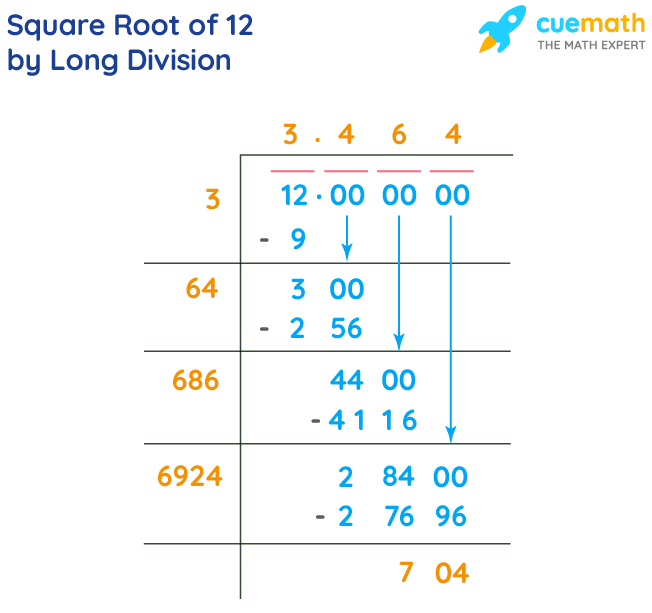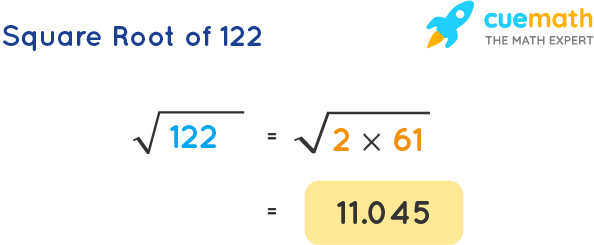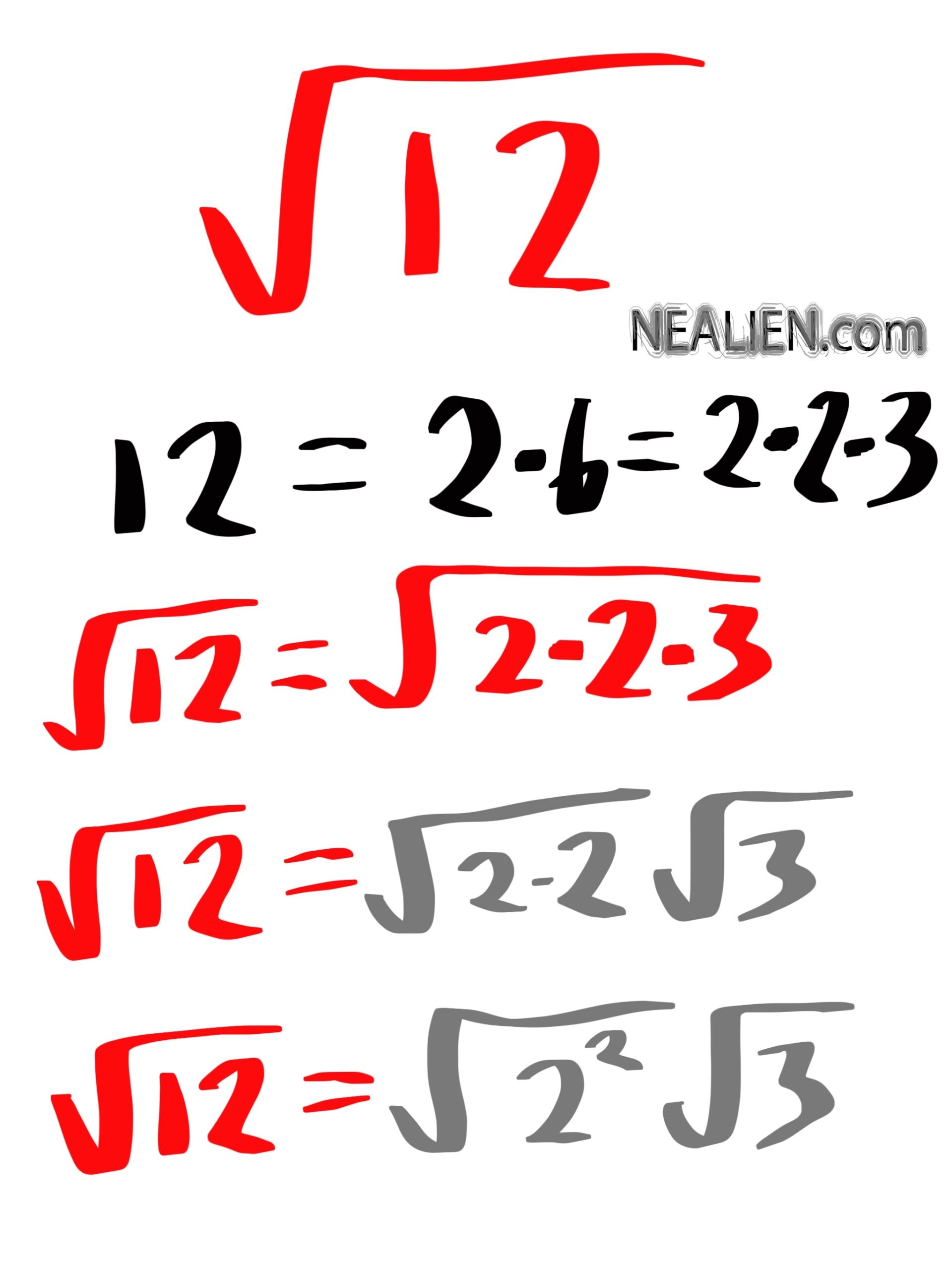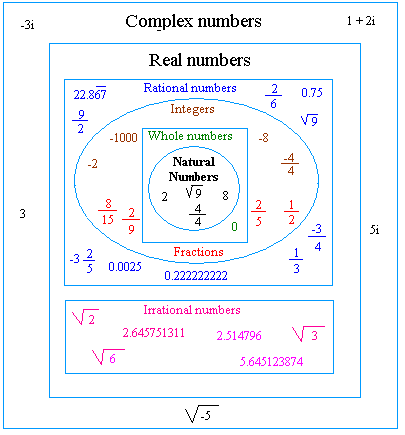Topic what is the square root of 12: Discover the fascinating details about the square root of 12. Learn how to express it in both radical and decimal forms, understand why it's an irrational number, and explore the methods used to find this value. Dive into the intriguing world of square roots and enhance your mathematical knowledge.
Table of Content
- Square Root of 12
- Introduction
- Definition of Square Root
- Representation of the Square Root of 12
- Methods to Calculate the Square Root of 12
- Simplification of the Square Root of 12
- Square Root of 12 in Decimal Form
- Square Root of 12 in Fractional Form
- Properties of the Square Root of 12
- Is the Square Root of 12 Rational or Irrational?
- Practical Applications of the Square Root of 12
- Frequently Asked Questions
- YOUTUBE:
Square Root of 12
The square root of 12 is represented in both radical and decimal forms. Here, we explore these representations and the methods to calculate the square root of 12.
Representation in Radical Form
The square root of 12 can be simplified by factoring 12 into its prime factors:
Therefore, the square root of 12 can be expressed as:
\(\sqrt{12} = \sqrt{2 \times 2 \times 3} = 2\sqrt{3}\)
Since \(2\sqrt{3}\) cannot be simplified further, it remains in this radical form.
Representation in Decimal Form
The decimal form of the square root of 12 is approximately:
\(\sqrt{12} \approx 3.464\)
This approximation is accurate up to three decimal places.
Calculation Methods
To find the square root of 12, one can use the prime factorization method:
- Factorize 12: 12 = 2 × 2 × 3
- Pair the prime factors: 2 and 2 are paired
- Take the square root of the pairs: \( \sqrt{12} = 2\sqrt{3} \)
Alternatively, using a calculator, you can find:
\(\sqrt{12} \approx 3.464\)
Square Root Table (1 to 15)
| Number | Square | Square Root (up to 3 decimal places) |
|---|---|---|
| 1 | 12 = 1 | \(\sqrt{1} = 1\) |
| 2 | 22 = 4 | \(\sqrt{2} = 1.414\) |
| 3 | 32 = 9 | \(\sqrt{3} = 1.732\) |
| 4 | 42 = 16 | \(\sqrt{4} = 2.000\) |
| 5 | 52 = 25 | \(\sqrt{5} = 2.236\) |
| 6 | 62 = 36 | \(\sqrt{6} = 2.449\) |
| 7 | 72 = 49 | \(\sqrt{7} = 2.646\) |
| 8 | 82 = 64 | \(\sqrt{8} = 2.828\) |
| 9 | 92 = 81 | \(\sqrt{9} = 3.000\) |
| 10 | 102 = 100 | \(\sqrt{10} = 3.162\) |
| 11 | 112 = 121 | \(\sqrt{11} = 3.317\) |
| 12 | 122 = 144 | \(\sqrt{12} = 3.464\) |
| 13 | 132 = 169 | \(\sqrt{13} = 3.606\) |
| 14 | 142 = 196 | \(\sqrt{14} = 3.742\) |
| 15 | 152 = 225 | \(\sqrt{15} = 3.873\) |
FAQs
- The square root of 12 in the lowest radical form is \(2\sqrt{3}\).
- The square root of 12 rounded to the nearest tenth is 3.5, to the nearest hundredth is 3.46, and to the nearest thousandth is 3.464.
- The square root of 12 lies between the integers 3 and 4.

READ MORE:
Introduction
The square root of 12, often represented as \(\sqrt{12}\), is a common mathematical expression encountered in various problems. It simplifies to \(2\sqrt{3}\) and is an example of a surd, which is an irrational number that cannot be expressed as a simple fraction. Understanding the square root of 12 involves exploring its properties, methods of calculation, and applications in different mathematical contexts.
- Definition and Properties
- Simplification of \(\sqrt{12}\)
- Decimal Representation
- Methods of Calculation
- Using a Calculator
- Using Long Division
- Using Prime Factorization
- Applications and Examples
- FAQs and Common Misconceptions
By understanding these aspects, one can grasp the significance and calculation of the square root of 12 effectively.
Definition of Square Root
The square root of a number is a value that, when multiplied by itself, gives the original number. It is represented by the radical symbol \(\sqrt{}\). The number under the radical symbol is called the radicand.
For example, the square root of 9 is 3 because \(3 \times 3 = 9\). Similarly, the square root of 16 is 4 because \(4 \times 4 = 16\).
In mathematical terms, if \(x^2 = a\), then \(x = \sqrt{a}\). The square root function is the inverse of squaring a number.
For the square root of 12, it can be expressed in its simplest radical form as:
\[
\sqrt{12} = \sqrt{4 \times 3} = 2\sqrt{3}
\]
In decimal form, the square root of 12 is approximately 3.464.
- The square root symbol \(\sqrt{}\) is known as a radical symbol.
- The radicand is the number inside the radical symbol.
- Square roots can be positive or negative because both \((3.464)^2\) and \((-3.464)^2\) equal 12.
Understanding square roots is essential in various mathematical contexts, including algebra, geometry, and calculus. They are fundamental in solving quadratic equations and understanding the properties of numbers.
Representation of the Square Root of 12
The square root of 12, represented mathematically as \( \sqrt{12} \), can be expressed in various forms, including its approximate decimal value, simplified radical form, and as a fractional exponent. Understanding these representations helps in comprehending its value and usage in different mathematical contexts.
- Decimal Form: The square root of 12 is approximately 3.4641. This is derived using calculators or computational tools.
- Radical Form: \( \sqrt{12} \) can be simplified by factoring the number under the radical. Since 12 = 4 × 3, it can be simplified to \( 2\sqrt{3} \).
- Fractional Exponent Form: In terms of exponents, \( \sqrt{12} \) is expressed as \( 12^{\frac{1}{2}} \).
| Representation | Value |
| Decimal Form | 3.4641 |
| Radical Form | 2\(\sqrt{3}\) |
| Fractional Exponent Form | 121/2 |
To calculate the square root of 12 manually, one can use methods like prime factorization or long division. Using the prime factorization method:
- Factorize 12 into its prime factors: 12 = 2 × 2 × 3.
- Pair the prime factors: \( \sqrt{12} = \sqrt{2^2 \times 3} \).
- Simplify the square root: \( \sqrt{12} = 2\sqrt{3} \).
Using the long division method:
- Set up the number 12 for long division.
- Find the largest number whose square is less than or equal to 12, which is 3 (since 3^2 = 9).
- Divide, average, and continue the process to reach a more precise value, which approximates to 3.4641.
These methods and representations show the versatility and various ways to express and compute the square root of 12, which is essential in different areas of mathematics and practical applications.
Methods to Calculate the Square Root of 12
The square root of 12 can be calculated using several methods. Here, we explore these methods in a detailed, step-by-step manner.
- Prime Factorization Method
- Start by writing the number 12 as the product of its prime factors:
\(12 = 2 \times 2 \times 3\)
- Express the square root of 12 using these factors:
\(\sqrt{12} = \sqrt{2 \times 2 \times 3} = 2\sqrt{3}\)
- Thus, the simplified form of the square root of 12 is \(2\sqrt{3}\).
- Start by writing the number 12 as the product of its prime factors:
- Long Division Method
- Pair the digits of the number starting from the decimal point and moving both left and right. Here, 12 has only one pair: 12.
- Find the largest number whose square is less than or equal to 12. This number is 3, since \(3^2 = 9\).
- Subtract 9 from 12, giving a remainder of 3.
- Bring down a pair of zeros and repeat the process to find the decimal places:
\(\sqrt{12} \approx 3.464\)
- Using a Calculator
- Enter the number 12 into the calculator.
- Press the square root (√) button.
- The calculator displays the result:
\(\sqrt{12} \approx 3.4641\)
- Using Exponential Form
- Recognize that the square root of a number can be expressed as an exponent of 1/2:
\(\sqrt{12} = 12^{1/2}\)
- Using a calculator or logarithmic tables, compute the value:
\(12^{1/2} \approx 3.4641\)
- Recognize that the square root of a number can be expressed as an exponent of 1/2:
These methods provide accurate ways to determine the square root of 12, whether you are doing so by hand or using technology.

Simplification of the Square Root of 12
To simplify the square root of 12, we need to express it in its simplest radical form. This process involves a few straightforward steps:
- List the factors of 12: 1, 2, 3, 4, 6, 12.
- Identify the perfect squares among the factors. The perfect squares are 1 and 4.
- Divide 12 by the largest perfect square, which is 4: \( 12 \div 4 = 3 \).
- Calculate the square root of the largest perfect square: \( \sqrt{4} = 2 \).
- Combine the results to simplify the square root: \( \sqrt{12} = \sqrt{4 \times 3} = \sqrt{4} \times \sqrt{3} = 2\sqrt{3} \).
Thus, the simplified form of \( \sqrt{12} \) is \( 2\sqrt{3} \).
Square Root of 12 in Decimal Form
The square root of 12, when expressed in decimal form, is an irrational number. This means it cannot be precisely represented as a simple fraction and its decimal expansion goes on infinitely without repeating. The square root of 12 is approximately 3.464.
To understand this better, here is a step-by-step breakdown of how to represent the square root of 12 in decimal form:
- First, we know that 12 lies between the perfect squares 9 (32) and 16 (42), so the square root of 12 will lie between 3 and 4.
- Using a calculator, we find the decimal approximation: √12 ≈ 3.464101615.
- For practical purposes, this value is often rounded to a few decimal places:
- To the nearest tenth: √12 ≈ 3.5
- To the nearest hundredth: √12 ≈ 3.46
- To the nearest thousandth: √12 ≈ 3.464
This approximation is useful in various mathematical applications where an exact radical form is not required.
Square Root of 12 in Fractional Form
The square root of 12, represented as \( \sqrt{12} \), is an irrational number, which means it cannot be expressed as an exact fraction. However, we can approximate it using fractional values.
First, let's simplify \( \sqrt{12} \) in its radical form:
- We start by expressing 12 as a product of its prime factors:
\( 12 = 2 \times 2 \times 3 \)
- We then group the factors into pairs and take out the square term:
\( \sqrt{12} = \sqrt{2 \times 2 \times 3} = 2\sqrt{3} \)
Since \( \sqrt{3} \) is an irrational number (approximately 1.732), \( 2\sqrt{3} \) is also irrational. To express this as a fraction, we can approximate it using the decimal form of \( \sqrt{3} \).
Let's approximate \( \sqrt{12} \) step by step:
- Use the decimal value of \( \sqrt{3} \):
\( \sqrt{3} \approx 1.732 \)
- Multiply by 2:
\( 2 \times 1.732 = 3.464 \)
- To express this as a fraction, we can use:
\( 3.464 \approx \frac{3464}{1000} \)
- Simplify the fraction:
\( \frac{3464}{1000} = \frac{433}{125} \)
Thus, the square root of 12 can be approximately expressed as \( \frac{433}{125} \) in fractional form. However, remember that this is an approximation, as the exact value of \( \sqrt{12} \) remains irrational.
Properties of the Square Root of 12
The square root of 12, represented as \( \sqrt{12} \), possesses several interesting properties. Here are the key properties explained in detail:
- Product Property: The square root of a product is equal to the product of the square roots of the factors. For example:
\[
\sqrt{12} = \sqrt{4 \times 3} = \sqrt{4} \times \sqrt{3} = 2\sqrt{3}
\] - Quotient Property: The square root of a quotient is equal to the quotient of the square roots of the numerator and the denominator. For example:
\[
\sqrt{\frac{12}{4}} = \frac{\sqrt{12}}{\sqrt{4}} = \frac{2\sqrt{3}}{2} = \sqrt{3}
\] - Rational and Irrational Components: The simplified form \( 2\sqrt{3} \) shows that the square root of 12 has both rational (2) and irrational (\(\sqrt{3}\)) components.
- Non-integer Square Root: Since 12 is not a perfect square, \( \sqrt{12} \) is an irrational number, meaning it cannot be expressed as a simple fraction.
- Approximation: The decimal approximation of \( \sqrt{12} \) is roughly 3.464, which is useful in practical applications requiring numerical solutions.
Understanding these properties can help in simplifying expressions and solving equations involving square roots.

Is the Square Root of 12 Rational or Irrational?
To determine whether the square root of 12 is rational or irrational, we need to understand the definitions of rational and irrational numbers:
- Rational Numbers: A number that can be expressed as a ratio of two integers (i.e., in the form \( \frac{p}{q} \), where \( p \) and \( q \) are integers and \( q \neq 0 \)). Examples include 1/2, 3, and -4.
- Irrational Numbers: A number that cannot be expressed as a ratio of two integers. These numbers have non-terminating, non-repeating decimal expansions. Examples include \( \pi \) and \( \sqrt{2} \).
Now, let's apply these definitions to the square root of 12:
- The square root of 12 is \( \sqrt{12} \).
- We can simplify \( \sqrt{12} \) as \( \sqrt{4 \times 3} \), which is \( \sqrt{4} \times \sqrt{3} \).
- Since \( \sqrt{4} = 2 \), we get \( 2\sqrt{3} \).
- The number \( \sqrt{3} \) is known to be an irrational number because it cannot be expressed as a fraction of two integers and its decimal expansion is non-terminating and non-repeating.
- Therefore, \( 2\sqrt{3} \) is a product of a rational number (2) and an irrational number (\( \sqrt{3} \)), which results in an irrational number.
Based on this analysis, the square root of 12 is an irrational number.
Here is a summary table:
| Number | Rational or Irrational |
|---|---|
| \( \sqrt{12} \) | Irrational |
Practical Applications of the Square Root of 12
The square root of 12, approximately 3.464, finds use in various practical applications across different fields. Here are some of the notable applications:
-
Geometry: In geometry, square roots are essential for calculating distances, areas, and dimensions. For instance, the length of the diagonal of a square with an area of 12 square units is calculated using the square root of 12.
If the area \( A \) of a square is 12, then the length of each side is \( \sqrt{12} \).
-
Physics: Square roots are frequently used in physics to solve problems involving distances, velocities, and accelerations. For example, the distance a free-falling object travels under gravity over a certain period can be computed using square root functions.
The formula for the distance \( d \) fallen in time \( t \) is \( d = \frac{1}{2} g t^2 \). If you know the distance and need to find the time, you use the square root.
-
Engineering: Engineers use square roots to determine stress and strain in materials, as well as to analyze waveforms and oscillations in systems. The natural frequency of a structure like a bridge can be calculated using the square root of specific parameters.
The natural frequency \( f \) can be given by \( f = \frac{1}{2\pi} \sqrt{\frac{k}{m}} \), where \( k \) is the stiffness and \( m \) is the mass.
-
Statistics: In statistics, the standard deviation is a key concept that involves square roots. The standard deviation provides a measure of the dispersion or variability in a set of data.
Standard deviation \( \sigma \) is calculated as \( \sigma = \sqrt{\frac{\sum (x_i - \mu)^2}{N}} \), where \( x_i \) are the data points, \( \mu \) is the mean, and \( N \) is the number of data points.
-
Computer Science: Square roots are used in various algorithms in computer graphics and cryptography. For example, calculating the distance between two points in a 2D or 3D space often involves square roots.
The distance \( D \) between points \( (x_1, y_1) \) and \( (x_2, y_2) \) in 2D is \( D = \sqrt{(x_2 - x_1)^2 + (y_2 - y_1)^2} \).
These are just a few examples of how the square root of 12, and square roots in general, are applied in real-world scenarios. Understanding and utilizing square roots is fundamental in many scientific, engineering, and mathematical fields.
Frequently Asked Questions
Here are some common questions about the square root of 12:
- What is the square root of 12?
The square root of 12 is approximately 3.4641016151377544.
- Is the square root of 12 rational or irrational?
The square root of 12 is an irrational number because it cannot be expressed as a simple fraction.
- What is the simplified form of the square root of 12?
The simplified form of the square root of 12 is \(2\sqrt{3}\).
- Can the square root of 12 be represented in exponential form?
Yes, the square root of 12 can be represented as \(12^{1/2}\).
- How do you calculate the square root of 12 using the long division method?
The long division method involves dividing 12 into smaller, more manageable parts and iteratively finding the square root. It yields an approximate value of 3.464.
- What are the practical applications of the square root of 12?
The square root of 12 is used in various fields such as engineering, physics, and geometry, often in calculations involving diagonal lengths or in solving quadratic equations.
Cách Đơn Giản Hóa Căn Bậc Hai của 12: Sqrt(12)













